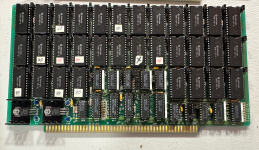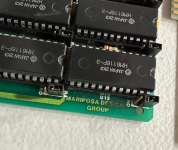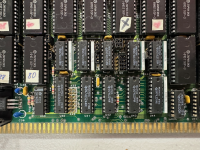sponaugle
Member
Is anyone familiar with this S-100 64K SRAM card?
It says "Mariposa Design Group" on the side, and has 64K of SRAM. Each SRAM has a small jumper that is labeled RA/RO (Read Only?).
The center of the PCB has a set of 4 jumpers labeled X0/G0 to X3/G3. Another jumper labeled GB, and another labeled EX. Near the bottom there are 8 jumpers for A19-A23, I assume to allow this SRAM to be places higher in memory in a system with 20 or 24 bit address bus.
This was is in an IMSAI 8080 I just got, but there were a number of cards that I think may have just been installed to store them. (3 different floppy controllers for instance). Would it be expected that this RAM card would have support for the PHANTOM signal?
The CPU card in this box is the Cromemco ZPU Z80 with the jump start set to 0xF000, and one of the floppy controllers has as ROM at 0xF000, so I assume the SRAM card would need to support the PHANTOM signal?
-Jeff



It says "Mariposa Design Group" on the side, and has 64K of SRAM. Each SRAM has a small jumper that is labeled RA/RO (Read Only?).
The center of the PCB has a set of 4 jumpers labeled X0/G0 to X3/G3. Another jumper labeled GB, and another labeled EX. Near the bottom there are 8 jumpers for A19-A23, I assume to allow this SRAM to be places higher in memory in a system with 20 or 24 bit address bus.
This was is in an IMSAI 8080 I just got, but there were a number of cards that I think may have just been installed to store them. (3 different floppy controllers for instance). Would it be expected that this RAM card would have support for the PHANTOM signal?
The CPU card in this box is the Cromemco ZPU Z80 with the jump start set to 0xF000, and one of the floppy controllers has as ROM at 0xF000, so I assume the SRAM card would need to support the PHANTOM signal?
-Jeff



